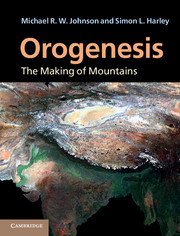Book contents
- Frontmatter
- Contents
- Preface
- Acknowledgments
- Geological timescale
- 1 Major features of the Earth and plate tectonics
- 2 Driving mechanisms for plates, slab retreat and advance, and a cause of orogenesis
- 3 Physical and chemical principles: rock deformation, isostasy, geochronology and heat production in the lithosphere
- 4 Large-scale features of orogens: thrusts and folds
- 5 Evolution of orogens
- 6 Lateral spreading of orogens: foreland propagation, channel flow and weak zones in the crust
- 7 Metamorphism in orogeny
- 8 The erosion and exhumation of mountains
- 9 Sedimentary history of the foredeep basins
- 10 Deep structure, mountain support and phase changes
- 11 Mountains and climate
- 12 Secular change in orogeny
- References
- Index
- Plate section
- References
3 - Physical and chemical principles: rock deformation, isostasy, geochronology and heat production in the lithosphere
Published online by Cambridge University Press: 05 June 2012
- Frontmatter
- Contents
- Preface
- Acknowledgments
- Geological timescale
- 1 Major features of the Earth and plate tectonics
- 2 Driving mechanisms for plates, slab retreat and advance, and a cause of orogenesis
- 3 Physical and chemical principles: rock deformation, isostasy, geochronology and heat production in the lithosphere
- 4 Large-scale features of orogens: thrusts and folds
- 5 Evolution of orogens
- 6 Lateral spreading of orogens: foreland propagation, channel flow and weak zones in the crust
- 7 Metamorphism in orogeny
- 8 The erosion and exhumation of mountains
- 9 Sedimentary history of the foredeep basins
- 10 Deep structure, mountain support and phase changes
- 11 Mountains and climate
- 12 Secular change in orogeny
- References
- Index
- Plate section
- References
Summary
The aim of this chapter is to set out some important physical and chemical properties which are highly relevant to the study of orogens and which are referred to in later chapters.
Rock deformation
The topic is covered in several excellent books, for example Ramsay and Huber (1983, 1987), Ramsay and Lisle (2000), or Jaeger and Cook (1976) (see Further Reading), and the discussion here is limited to giving a basic introduction to the subject.
The fact that some rocks have been deformed was probably first recognised by James Hutton towards the end of the eighteenth century, because at Siccar Point near Edinburgh he realised that some rock strata had been tilted so that the bedding was now dipping in a near vertical attitude. This was an amazing insight at the time: he realised that the strata had been rotated from their horizontal attitude on the sea-bed.
It was in the nineteenth century that Swiss geologists presented evidence in the form of folds and thrusts, clearly visible on mountain sides, that rocks had been subjected to compression, as well as evidence that rocks had been stretched. Faced with this evidence which has been confirmed in many parts of the world, we are forced to consider the strengths of rocks in orogenic belts. If you sit by a river and watch the intricate patterns of air bubbles that result from the complex flow patterns of the river then you get a feeling for what happens when rocks lose their strength and flow.
- Type
- Chapter
- Information
- OrogenesisThe Making of Mountains, pp. 16 - 44Publisher: Cambridge University PressPrint publication year: 2012

